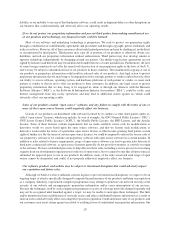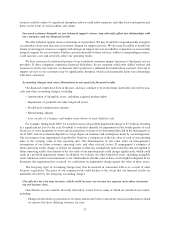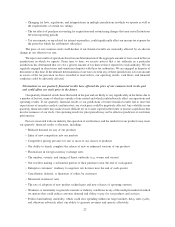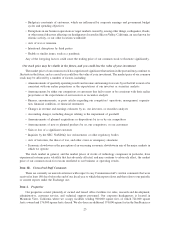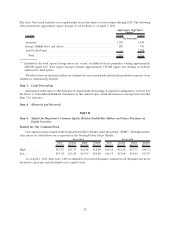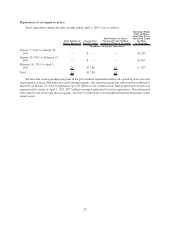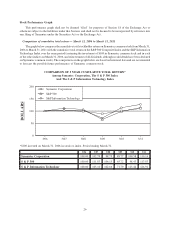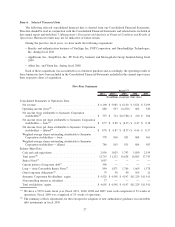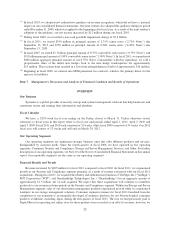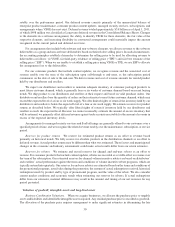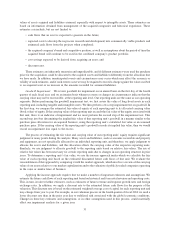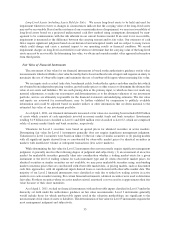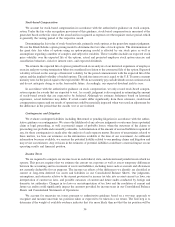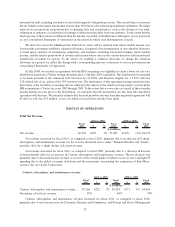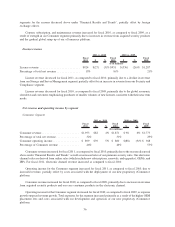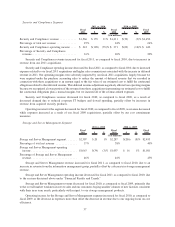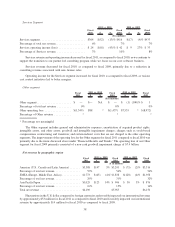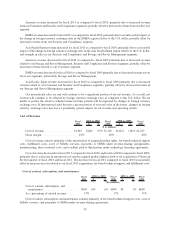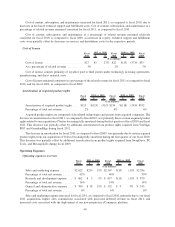Symantec 2011 Annual Report Download - page 100
Download and view the complete annual report
Please find page 100 of the 2011 Symantec annual report below. You can navigate through the pages in the report by either clicking on the pages listed below, or by using the keyword search tool below to find specific information within the annual report.ratably over the performance period. Our deferred revenue consists primarily of the unamortized balance of
enterprise product maintenance, consumer product content updates, managed security services, subscriptions, and
arrangements where VSOE does not exist. Deferred revenue totaled approximately $3.8 billion as of April 1, 2011,
of which $498 million was classified as Long-term deferred revenue in the Consolidated Balance Sheets. Changes
to the elements in a software arrangement, the ability to identify VSOE for those elements, the fair value of the
respective elements, and increasing flexibility in contractual arrangements could materially impact the amount
recognized in the current period and deferred over time.
For arrangements that include both software and non-software elements, we allocate revenue to the software
deliverables as a group and non-software deliverables based on their relative selling prices. In such circumstances,
the accounting principles establish a hierarchy to determine the selling price to be used for allocating revenue to
deliverables as follows: (i) VSOE, (ii) third-party evidence of selling price (“TPE”) and (iii) best estimate of the
selling price (“ESP”). When we are unable to establish a selling price using VSOE or TPE, we use ESP to allocate
the arrangement fees to the deliverables.
For our consumer products that include content updates, we recognize revenue and the associated cost of
revenue ratably over the term of the subscription upon sell-through to end-users, as the subscription period
commences on the date of sale to the end-user. We defer revenue and cost of revenue amounts for unsold product
held by our distributors and resellers.
We expect our distributors and resellers to maintain adequate inventory of consumer packaged products to
meet future customer demand, which is generally four or six weeks of customer demand based on recent buying
trends. We ship product to our distributors and resellers at their request and based on valid purchase orders. Our
distributors and resellers base the quantity of orders on their estimates to meet future customer demand, which may
exceed the expected level of a four or six week supply. We offer limited rights of return if the inventory held by our
distributors and resellers is below the expected level of a four or six week supply. We estimate reserves for product
returns as described below. We typically offer liberal rights of return if inventory held by our distributors and
resellers exceeds the expected level. Because we cannot reasonably estimate the amount of excess inventory that
will be returned, we primarily offset deferred revenue against trade accounts receivable for the amount of revenue in
excess of the expected inventory levels.
Arrangements for managed security services and SaaS offerings are generally offered to our customers over a
specified period of time, and we recognize the related revenue ratably over the maintenance, subscription, or service
period.
Reserves for product returns. We reserve for estimated product returns as an offset to revenue based
primarily on historical trends. We fully reserve for obsolete products in the distribution channels as an offset to
deferred revenue. Actual product returns may be different than what was estimated. These factors and unanticipated
changes in the economic and industry environment could make actual results differ from our return estimates.
Reserves for rebates. We estimate and record reserves for channel and end-user rebates as an offset to
revenue. For consumer products that include content updates, rebates are recorded as a ratable offset to revenue over
the term of the subscription. Our estimated reserves for channel volume incentive rebates are based on distributors’
and resellers’ actual performance against the terms and conditions of volume incentive rebate programs, which are
typically entered into quarterly. Our reserves for end-user rebates are estimated based on the terms and conditions of
the promotional programs, actual sales during the promotion, the amount of actual redemptions received, historical
redemption trends by product and by type of promotional program, and the value of the rebate. We also consider
current market conditions and economic trends when estimating our reserves for rebates. If actual redemptions
differ from our estimates, material differences may result in the amount and timing of our net revenues for any
period presented.
Valuation of goodwill, intangible assets and long-lived assets
Business Combination Valuations. When we acquire businesses, we allocate the purchase price to tangible
assets and liabilities and identifiable intangible assets acquired. Any residual purchase price is recorded as goodwill.
The allocation of the purchase price requires management to make significant estimates in determining the fair
30


